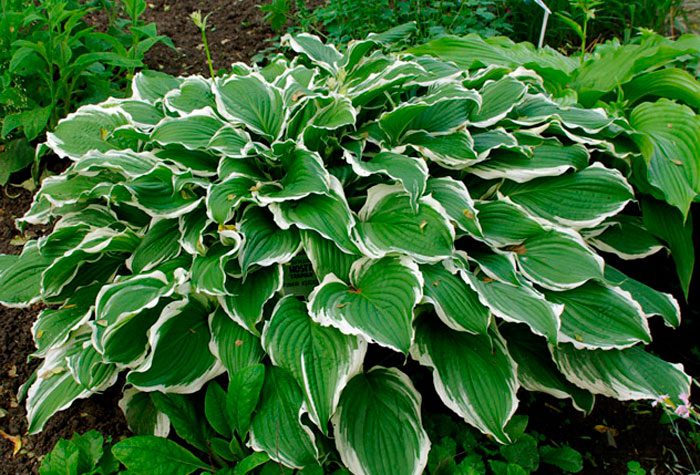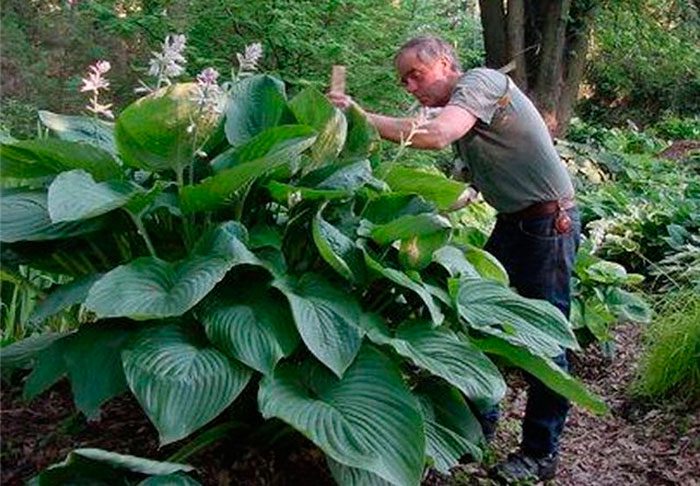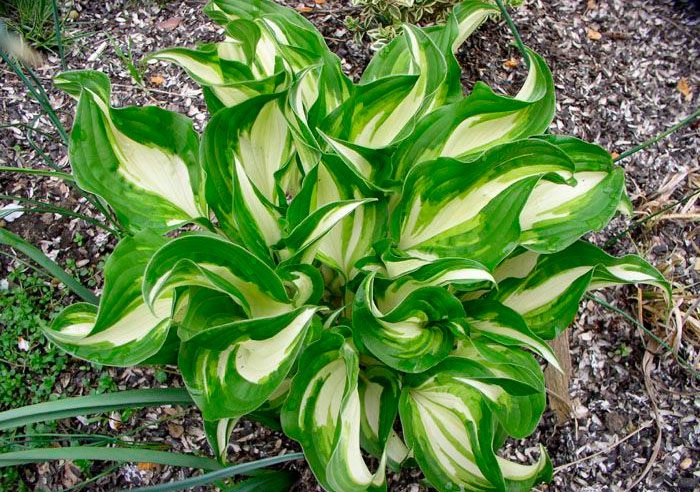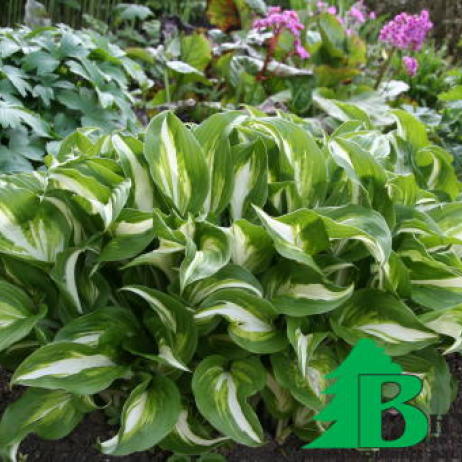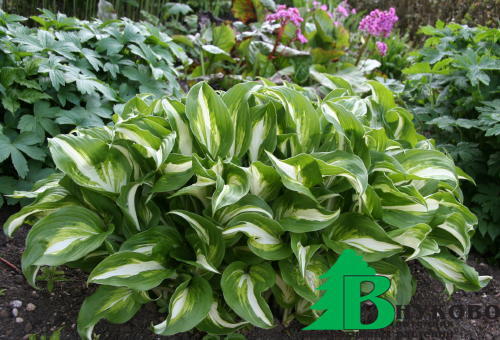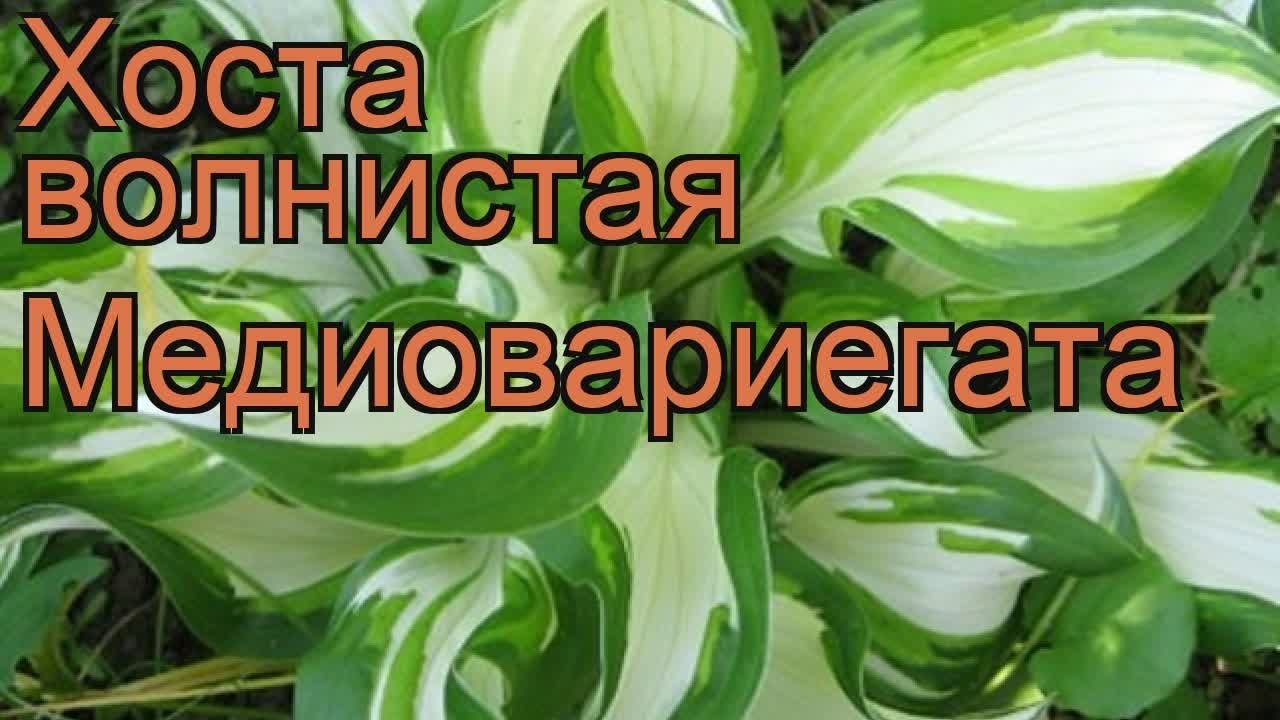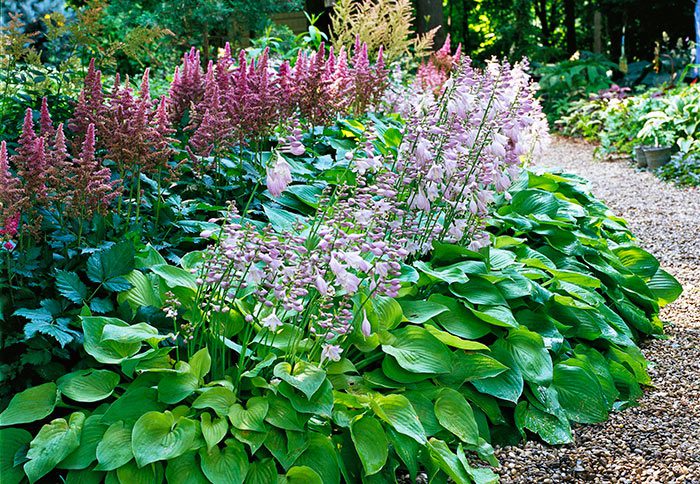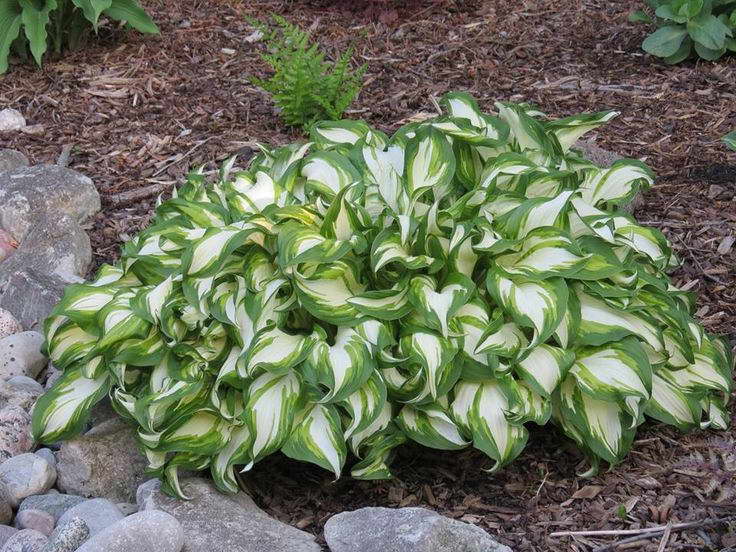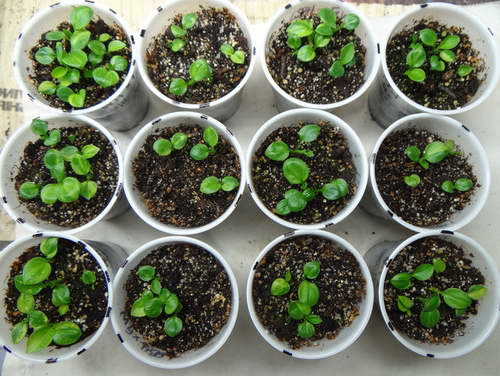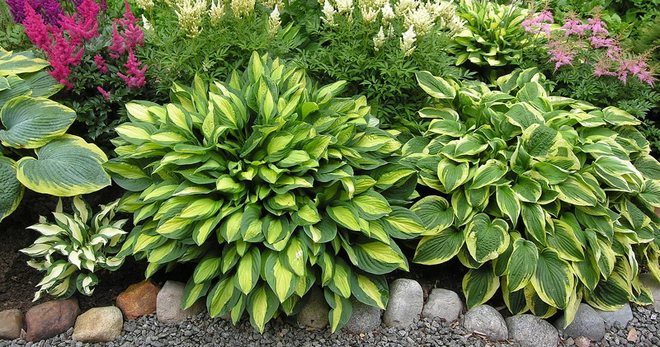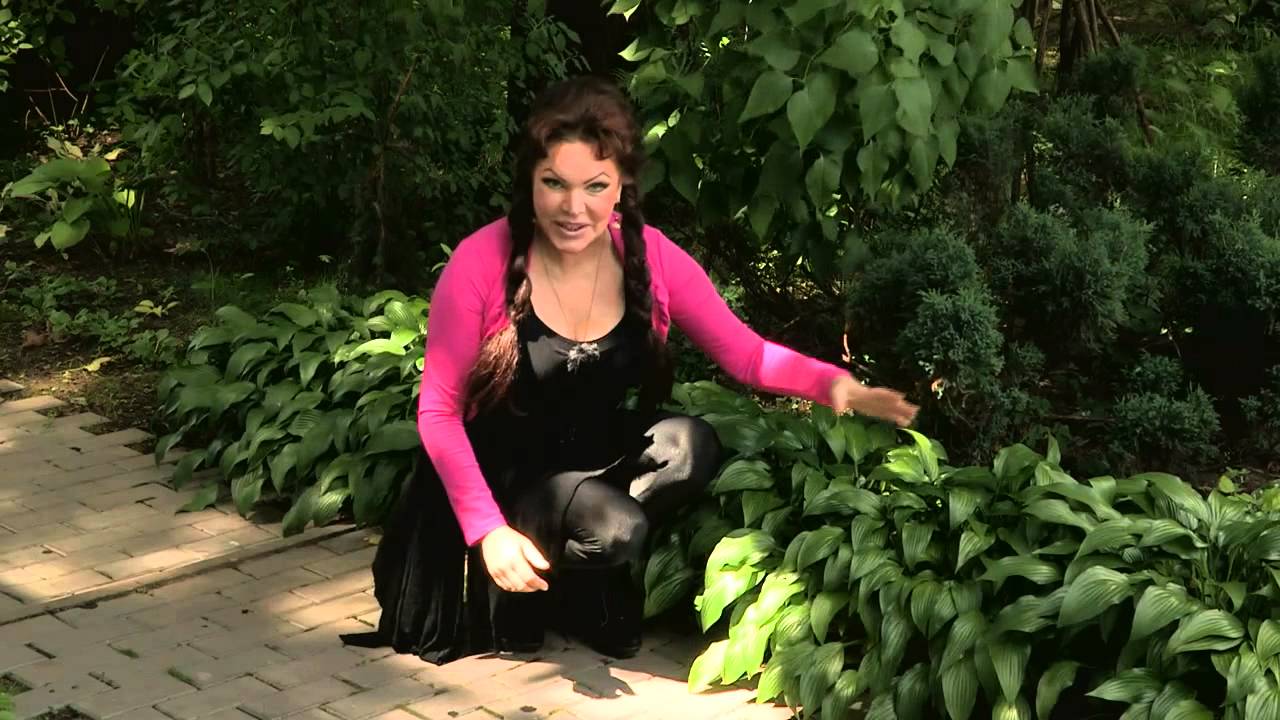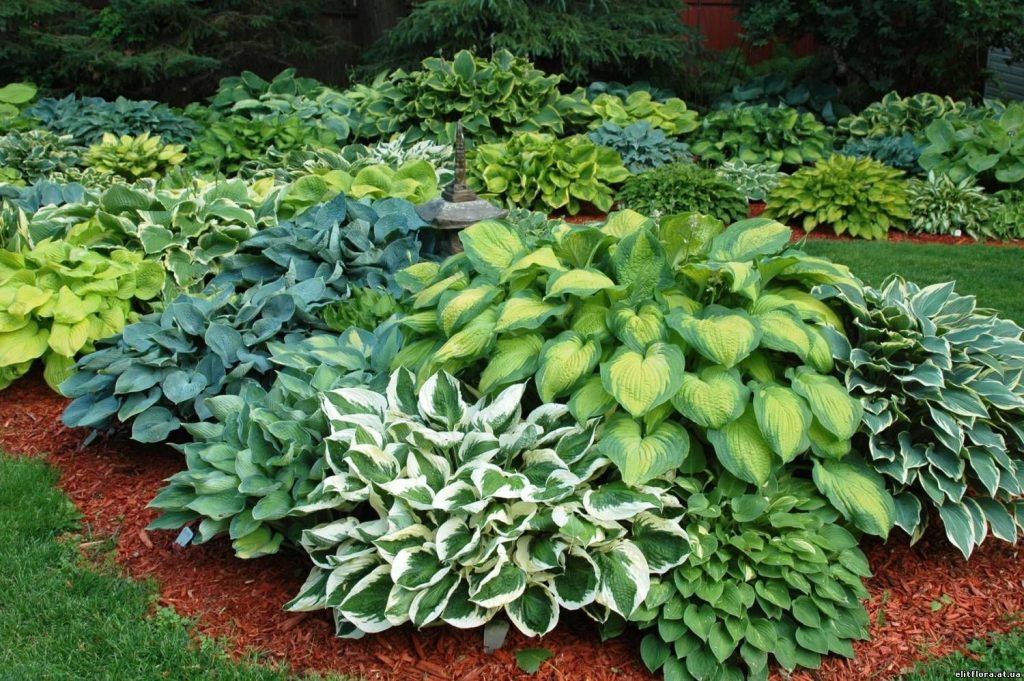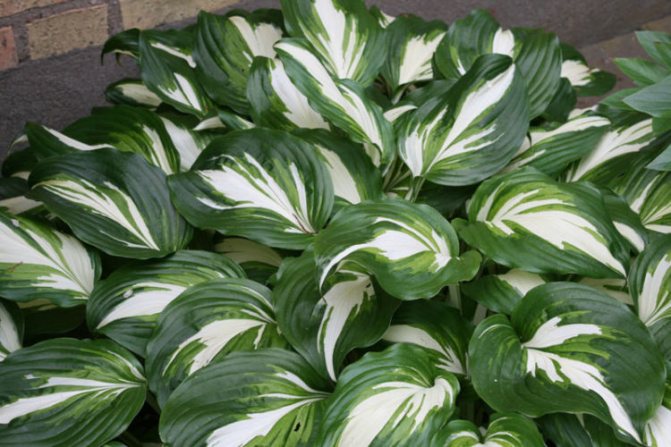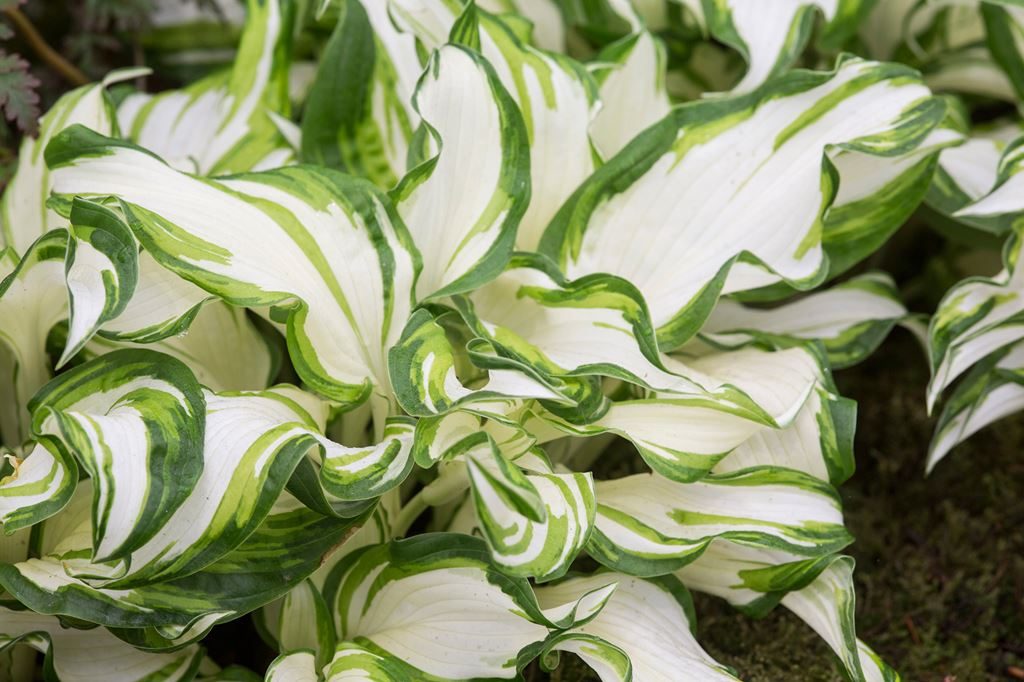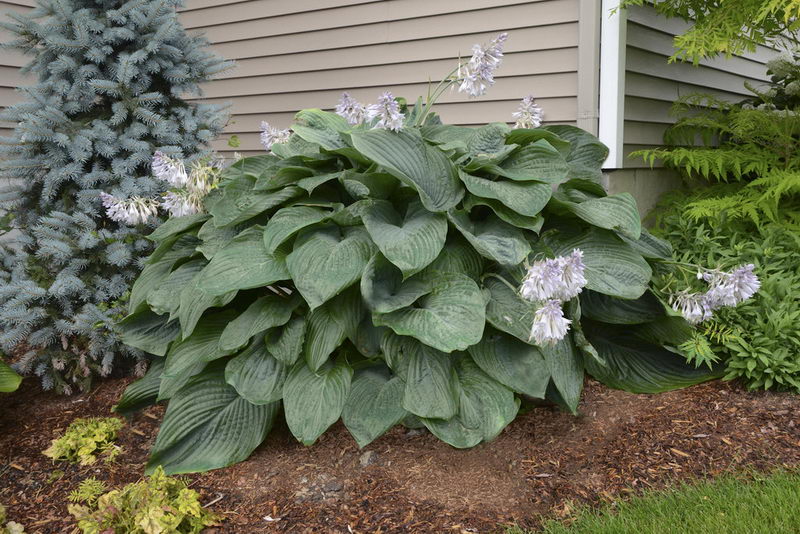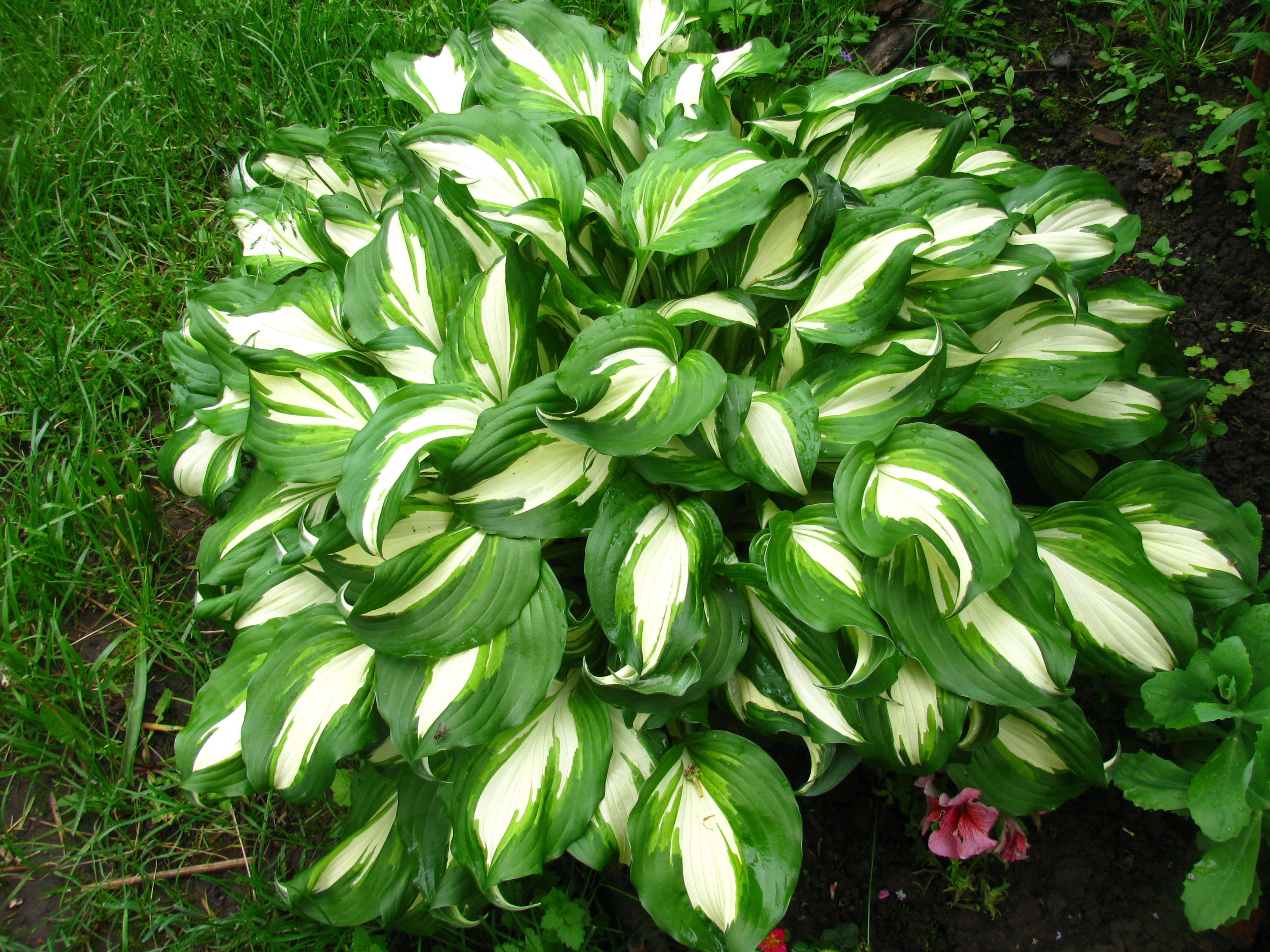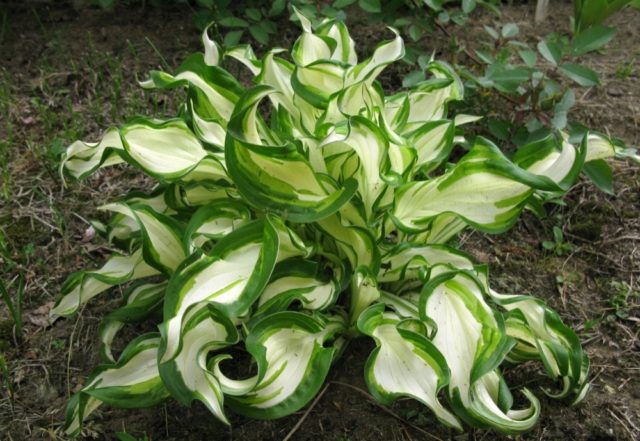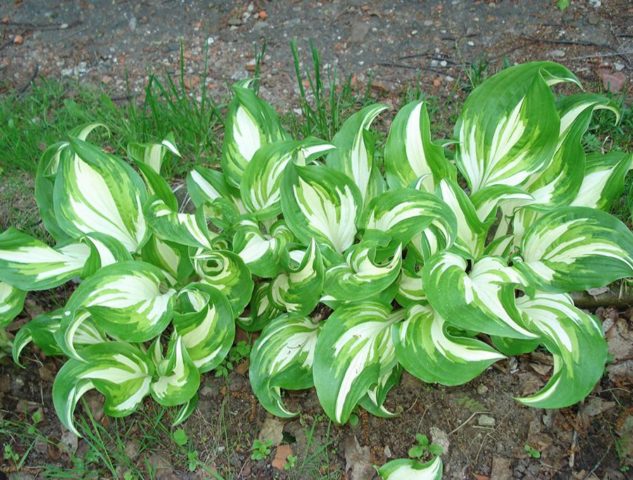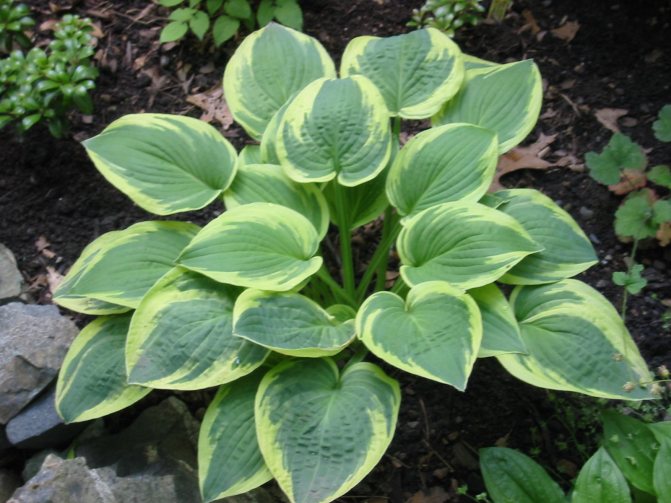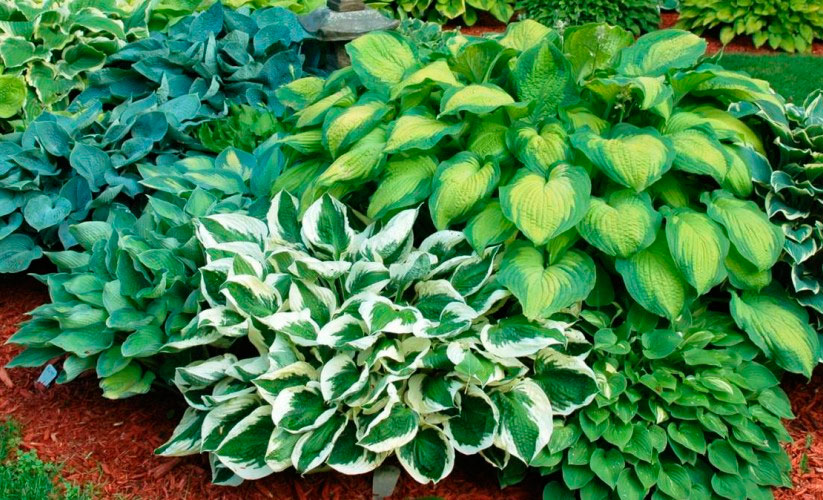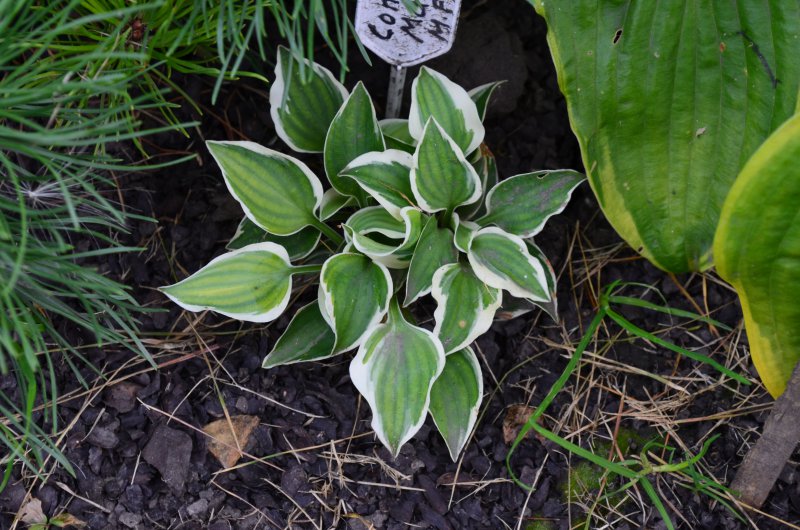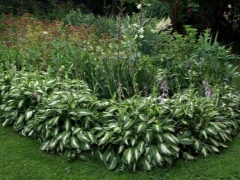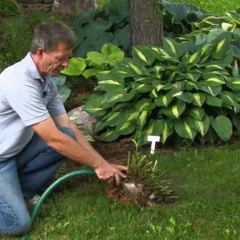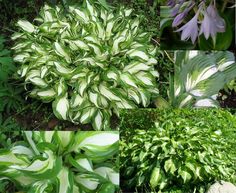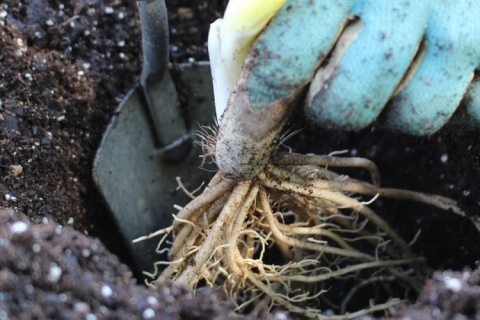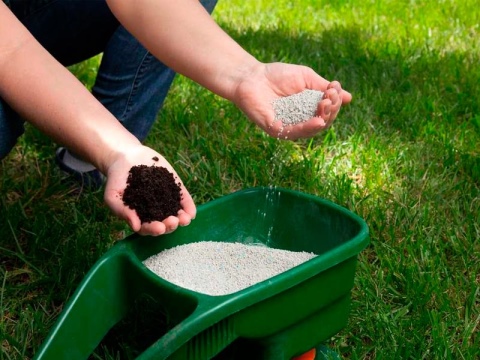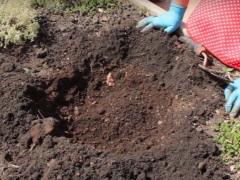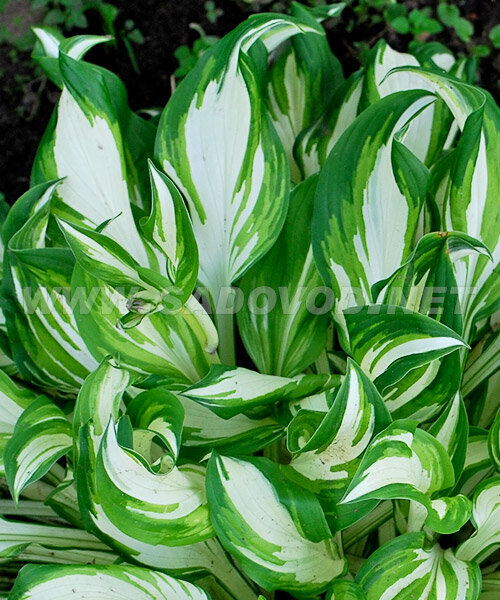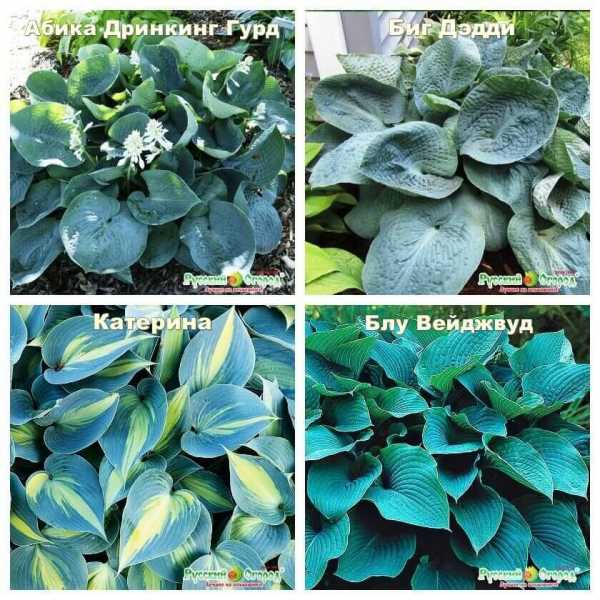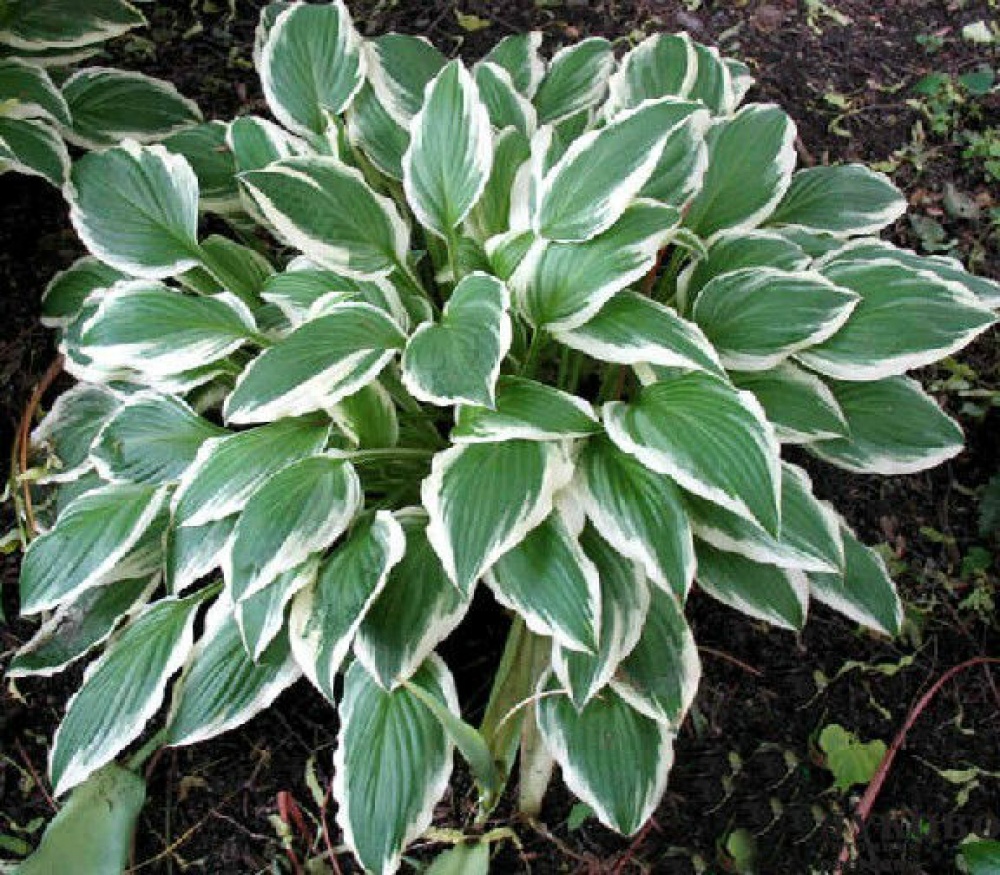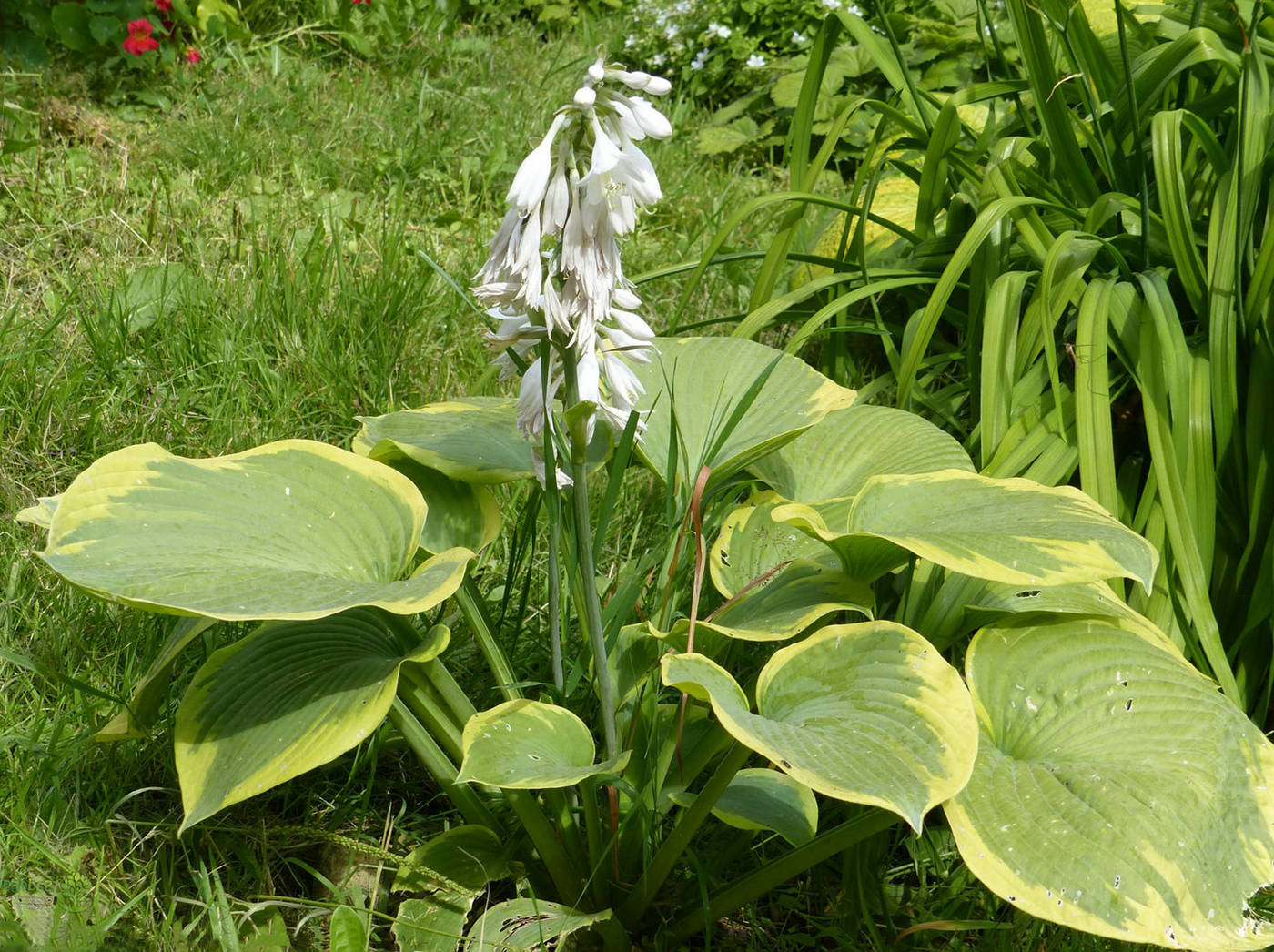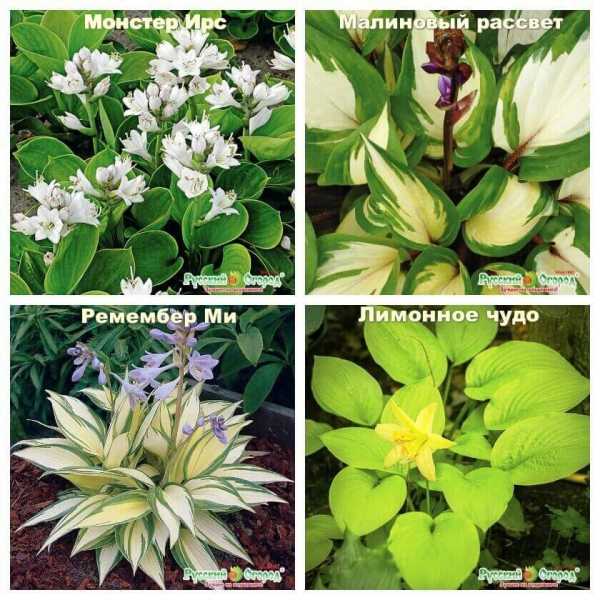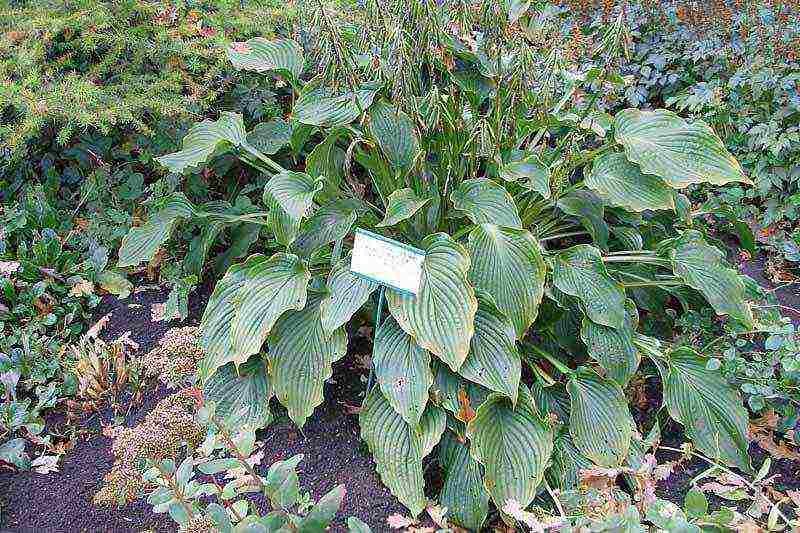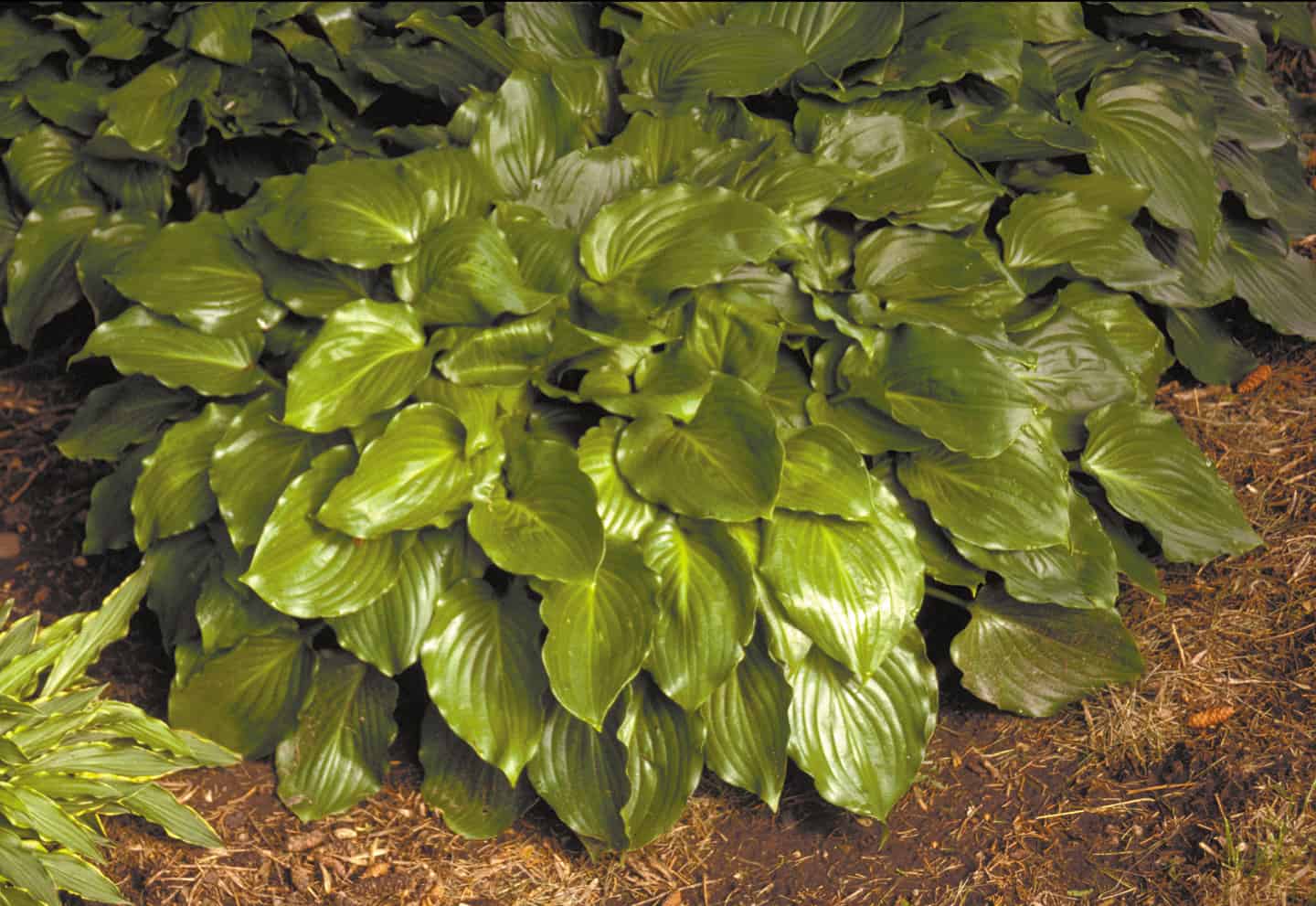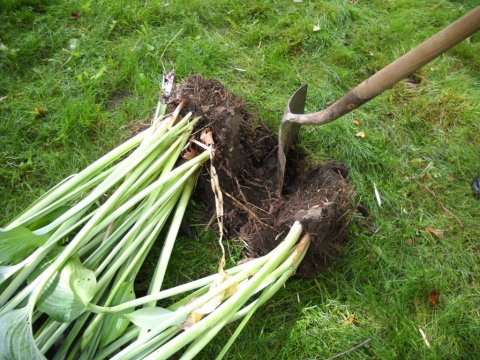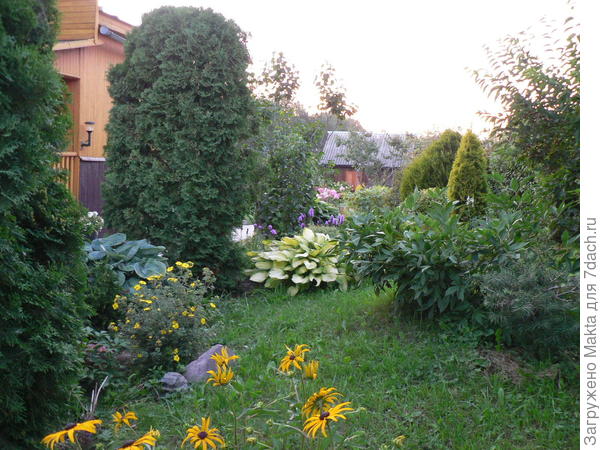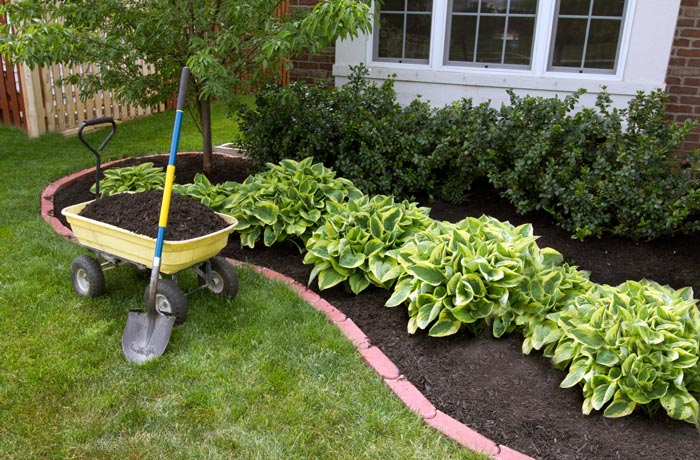Description of the host plant Mediovariety
The rhizome, according to the description, is thickened, with many long filamentous roots - just right for moist fertile soils, where the hosta is undulating and inhabits.

Lat. Hósta (photo)
The funnel-shaped buds of the hosta resemble lily flowers. But they appreciate it primarily for the leaves. They are cohesive at the basal thickenings sometimes reaching one meter in diameter and are different in size, shape and color.
The range of variations is very extensive - the leaves are found both not exceeding the size of a match, and growing up to half a meter, in light and dark tones of green and gray-blue.
Mediovariegata is a hosta variety that is distinguished by its simplicity and adaptability to environmental conditions. The name of the variety is given due to the color of the leaves.
Mediovariegata was bred in 1930 and immediately became widespread. It is not surprising, because with the beauty of its multi-colored and slightly swirling leaves, the Mediovariety will perfectly decorate any flower bed or area. Also, as the description says, this variety is notable for its early flowering.
Almost any soil is appropriate, however, the best option for its favorable development would be loose soils with moderate moisture and weak acidity. Fertilizers are welcome, mainly on poor soils. Minerals, humus, compost and peat will replace the scarcity of such soil for the hosts.
The color of such a hosta is delicate and pleasant. The leaves are light green in color with a patterned white part in the center, and the flowers are bluish or pale purple. The buds themselves are up to 5 cm in size, and the flower-bearing stems are up to 80 cm long. The flowers have no aroma.
Diseases and pests
Hosts are practically not susceptible to infectious lesions. Bacterial and fungal diseases are rare. The main reason is improper care or the presence of infected plants in the immediate vicinity.
Common diseases:
- root rot;
- phyllostictosis;
- gray rot;
- rust;
- viral lesions.
In the course of treatment, the affected areas of the plant must be removed. The bush, as well as the soil around, is treated with a fungicide. During the treatment period, watering is temporarily reduced.
Mulching from shell rock and broken rubble can help slugs
The most common pests of "Mediovariyegata" are aphids, snails, scoops, slugs and nematodes. They usually appear in dry weather. As a treatment, the hostu, as well as neighboring plants, are sprayed with insecticides. Preventive treatment is recommended every spring.
Reproduction
Undulata Mediovariegata, like other hosta species, reproduces in the following ways.
- Bush division. The best time for this procedure is spring and late summer. The shrub must be divided into parts, using a sharp knife, shovel. For good rooting of cuttings, the foliage of the culture should be cut in half.
- Seeds. This method does not guarantee the preservation of all the characteristics of the variety during cultivation, therefore it is rarely used. The host is sown in spring after winter stratification or just before frost. Seedling development is a lengthy procedure. The plant will be able to achieve decorative attractiveness only by the 4th year of life.
- In a vegetative way. This breeding option is considered the most effective. The kidneys are placed in an artificial environment, where they grow at the correct temperature and humidity. After a few weeks, the planting material can be used to separate new buds.
Description of wavy hosts MediaVariety
The variety was bred in Japan in 1930. This fast-growing perennial plant belongs to the lily family.
Outwardly, it is a hemispherical bush. The average height of an adult hosta "Mediovariety" is 50 cm, the bushes grow up to 60-70 cm wide.
Hosta decorates gardens and household plots with its flowering
"Mediovariegata" is dark green in color. During the growing season, the host has a large number of stems and leaves. In spring, before the onset of hot weather, the color of the shoots is dark green. In summer, when there is abundant sunshine, the "Mediovariyegata" brightens up.
The leaves have a raised, pointed edge. The surface in the center is white with a green border on the sides. The length of the sheets is up to 15 cm.
In June, less often at the end of May, the plant blooms. As you can see in the photo of the hosts of "Mediovariety", a large number of light purple flowers appear on the bushes. They are funnel-shaped and hold on long (up to 70 cm) pedicels.
"Mediovariygata" does not create problems in maintenance, frost-resistant and has an attractive decorative appearance
It is recommended that the host "Mediovariygata" grow in a shaded area or in partial shade. The plant is uncomfortable in the sun. Due to the abundant lighting, moisture evaporation accelerates, especially in hot weather. The lack of liquid can cause serious damage to the bush, especially during the period of bud formation. With a lack of moisture, the tips of the leaves of the hosta darken.
"Mediovariegata" is not sensitive to low temperatures. Therefore, it can be grown in any region. The "Mediovariyegata" bush tolerates frost well down to -30 degrees for a long period of time.
Application in landscape design
This hosta variety is very beautiful. Thanks to the unique color of the leaves, "Mediovariety" can be used as an independent decorative element. Bushes are often planted on lawns, near water bodies and fruit trees. The plant will be a good zoning solution when you need to visually divide the area.
"Mediovariety" looks good against the background of other hosts. The main thing is that the neighboring plants are of the same color.
When disembarking, the host is best combined with:
- irises;
- peonies;
- gladioli;
- phlox;
- geycher;
- lilies;
- astilbe;
- primroses;
- ferns.
The plant is able to achieve decorative attractiveness only by the 4th year of life.
Tall ornamental plants should not be planted too close to the host, otherwise it may become invisible in the overall composition.
Important! Shrubs and flowers should be planted near the "Mediovariygata", which have similar requirements for the composition, soil moisture and the degree of illumination of the site. Wavy hosta is ideal for growing in rock gardens
There they should be combined with other low perennials or annual flowers.
Wavy hosta is ideal for growing in rock gardens. There they should be combined with other low perennials or annuals.
Care
The function of undulata Mediovariyegata is an unpretentious plant that is quite easy to care for. All she needs is regular but moderate watering, annual pruning and a few dressings per season.
Watering
Water the funkia 2-3 times a week, depending on the condition of the soil. The soil should be moderately moist, but free from dirt or stagnant water. Watering is carried out in the morning, directing the stream under the root, and not over the leaves.

Host media variety photo
Top dressing
Spring and autumn feeding is combined with mulching. The soil around the bush is covered with peat or compost, creating a supply of nutrients, reducing evaporation, protecting the roots from overheating and facilitating maintenance.
At the beginning of the flowering period, you can additionally feed the funky with complex mineral fertilizers.
Pruning and preparing for winter
After flowering, dry peduncles are pruned, and with the onset of autumn colds, yellowed leaves. Some gardeners choose to prune their shrubs in the spring rather than in the fall. For the winter, you can cover adult hosts with dry foliage, and young seedlings with spruce branches.
Growing rules
The plant does not need specific care. A minimum set of activities is possible, which is enough for the host to grow well.
The place where the bush is located must be regularly cleared of weeds. This is done by hand or using a garden tool. Fast growing weeds with long, curling shoots are especially dangerous. They can twine around the host, after which it will take a lot of effort to free the bush.
Since "Mediovariygata" is a moisture-loving plant, regular watering is required. It is carried out taking into account climatic conditions. In the spring, the bushes are watered with settled water 3-4 times a month. In summer, when the weather is hot and there is no precipitation, the frequency is increased to 2-3 times a week. Each bush requires at least 10 liters of water.
From time to time "Mediovariyegata" needs a sanitary haircut. Withering or discolored leaves, dried shoots are cut from the bushes.
In the spring, the hostu is fed with organic fertilizers. Compost, humus, peat, tree bark and bird droppings are used. Organic fertilizing enriches the soil with nutrients over a long period of time. For the winter, these types of fertilizers are not recommended.
Mineral feeding is also carried out in early spring. To do this, use liquid or granular products containing potassium, phosphorus and nitrogen. Re-fertilization is carried out in the summer, after flowering, as well as in the fall, when persistent cold weather sets in.
Before planting, the soil must be well dug up with organic fertilizers.
To preserve moisture in the soil, mulching is carried out. This procedure is carried out simultaneously with loosening the soil. The depth of processing is at least 8 cm. As mulch, bark, peat, dry compost and straw are used. Another option is a mixture of dry leaves, sawdust and hay.
Preparing for winter
In the southern regions, where temperatures rarely drop below -20 ° C, preparation for the cold season is not required. In the fall, it is recommended to apply mineral fertilizer, to mulch the soil. At the end of October, foliage is removed from the hosts and the stems are cut, leaving basal shoots 3-5 cm long.
The stem of the hosta should be cut off immediately after the end of the flowering phase.
If a cold winter is predicted, it is better to cover the plant. For this, spruce branches and pine branches are used. You can cover the bush with dry foliage, sawdust, straw or hay.
Important! It is impossible to cover "Mediovariyegata" with plastic wrap, as it will restrict the plant's access to oxygen. In addition, pests can grow under the synthetic material.
Features of preparing hosts for the winter season:
Pests and diseases hosts
A large number of single-growing host varieties may be at risk of infection.
The fungal disease phyllosticosis is one of such misfortunes. Treatment can only be the destruction of infected specimens and disinfection of the area. Another fungus, sclerotinia, is treated with dichlorane.
Garden pests are also dangerous for such a bush. You can fight slugs with a home method - lure them with containers with beer placed around the plants, then collect and take them away. But the elimination of caterpillars and grasshoppers that can cause catastrophic damage can only be ensured by the use of chemicals.
While watching the video, you will learn about taking care of the host.
Hosta Mediovariegata (wavy) is able to skillfully decorate any area, from a small flower bed to a garden. The ability to plant and grow it correctly is very valuable. And knowledge about caring for it will be a great help in maintaining the beauty of this plant.
Landing features
Like all variegated hosts, Mediovariegata wavy prefers light partial shade or diffused sunlight to complete shade. It grows well in the shade, but the leaves are not so bright, variegated and contrasting. The function loves fertile soils, loams with a neutral or slightly acidic reaction.
The plant should not be planted in places where melt and rain moisture accumulates, as well as in places where groundwater is located close to the surface. If there is no choice, it is necessary to make an embankment before planting and provide the hole with a thick layer of drainage.
Technology:
- In the dug and loosened area, a hole is dug with a diameter and depth of 50-60 cm.
- The bottom is covered with a drainage layer (gravel, pebbles, broken brick).
- Garden soil is mixed with rotted manure, compost, peat, mineral fertilizers.
- The hole is covered by a third with a substrate, poured with a bucket of water and wait until the moisture is absorbed.
- Place the plant with the lump.
- The remaining soil mixture is poured, tamped, watered again, mulched with pine needles or bark.
Caring for the host in the garden
The host is fed by compost and humus. But if the bush is planted in a fertile place, then feeding is not required for two to three years.
Mineral fertilizers are generally best avoided. And feeding with liquid fertilizers lasts until mid-July with a regularity of once every 2 weeks.
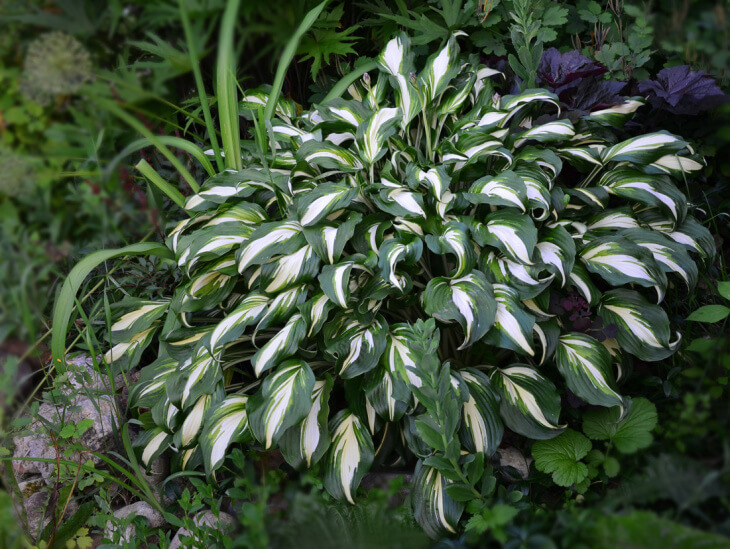
Decorating the dacha territory by the host (photo)
This is explained by the fact that the host takes time to prepare for the winter season, and with continuous feeding, it will only be busy with growing leaves.
Along with the content of nutrients in the soil, the plant requires moisture, moreover, constant. Darkened tips of the leaves are a symptom of the need for water.
It is important to water such a plant correctly: do not get on leaves spoiling from moisture, regulate the water pressure in order to avoid soil compaction and water in the early morning
6.Species:
Hosta varieties and species can be conditionally divided into groups by height (a similar classification was discussed above) and by leaf color. Varietal and specific plants are divided into blue, yellow, green and variegated according to their appearance.
6.1. Hosta Siebold - Hosta sieboldiana
Sufficiently tall plants - bushes can reach 60 - 90 cm in height and have many wide, glossy, green leaf plates. In length, the leaves can reach 30 - 40 cm. Flowering occurs at a fairly early date - in late spring or June. The buds are white, drooping, bell-shaped.

6.2. Hosta plantaginea - Hosta plantaginea
Quite large perennials, whose height can reach 70 cm. They are decorative leafy plants with oblong, broadly lanceolate leaves of light green color. The surface of the leaf plates is covered with a large number of leaf veins. Tubular white buds form on erect peduncles in August or even early September. The main distinguishing feature of this species is the presence of an intense aroma during the flowering period.
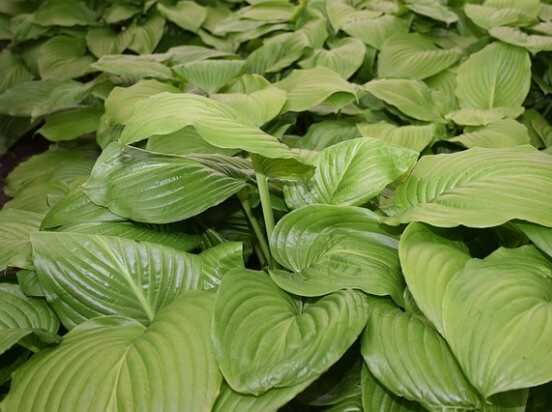
6.3 Hosta Fortunei
Herbaceous perennials 45 - 60 cm high with heart-shaped green leaves up to 25 cm long. In the second half of summer, plants adorn themselves with peduncles with numerous white or lilac buds.
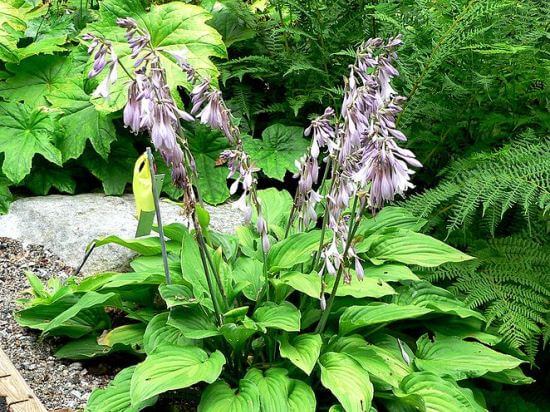
6.4. Wavy host - Hosta undulata
Spectacular perennials up to 60 - 90 cm high with dashingly twisted leaf blades. Leaves are oblong-lanceolate, green, with edges curved in different directions. Peduncles appear in the first half of summer and bear numerous lilac tubular flowers.

6.5 Hosta minor
One of the smallest species - the height of even adult bushes does not exceed 10-15 cm. Due to their small size, these are ideal plants for creating a border or growing at home. The leaf blades are broadly lanceolate, reaching a length of 5-10 cm. The flowers are thin, graceful, rich in lilac shade.
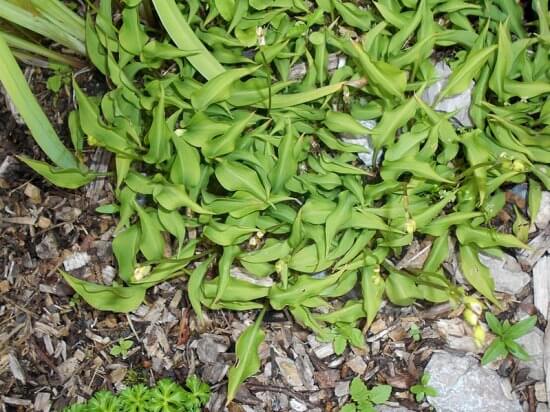
6.6. White-bordered host - Hosta albomarginata
Attractive herbaceous perennials, whose height easily reaches 60 - 90 cm. The leaves are dark green, oblong, with a wavy edge. The edging of the leaf plates is a thin white stripe. The flowers are lilac, appear in the second half of summer.
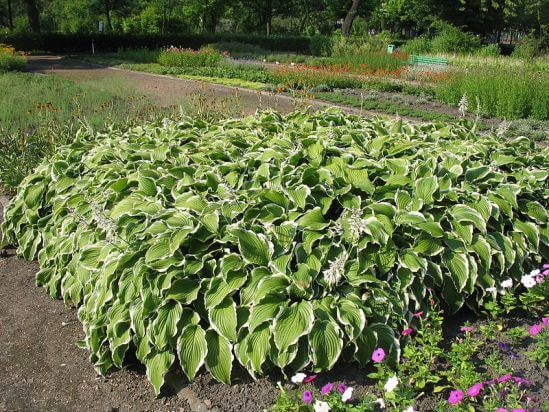
6.7. Hosta lanceolate or narrow-leaved - Hosta lancifolia
Low-growing species - the height of plants does not exceed 20 - 30 cm. A distinctive feature of the species are green, long, lanceolate leaves with a glossy surface. The flowering period begins in the second half of summer, when light purple buds are formed.
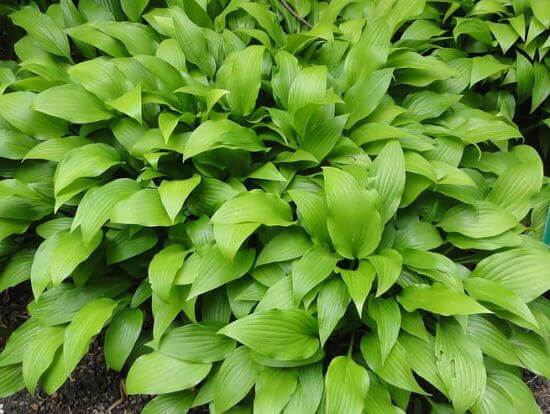
Use in landscape design
Hosta undulata Mediovariegata is widely used in landscape design. It fits well into natural-style gardens, rock gardens, rockeries, flower gardens. A lush bush fills the space under trees and perennials with leafless stems. It looks great as a tapeworm, can serve as a living border and complement group compositions.

Hosta mediovariegata
The function is suitable for container growing, which allows landscaping of yards without planting land. It goes well with conifers, cereals, monochromatic green shrubs. In the flower garden, a rose, delphinium, astilbe, daylily, and peony will become a good neighbor for her.
Agricultural technology of cultivation
This plant is able to grow well in various types of soil. However, hosta Undulata prefers friable with moderate moisture, which is combined with mild acidity. At the same time, loam and sand are undesirable for them.
When planting a plant, you need to take into account what kind of illumination there is in this place. The best option for a flower will depend on the color of the leaves. If they are bright green, good lighting may be the best choice. In the case when the leaves are gray-blue in color, they are more suitable when the sunlight falls on them for no longer than two hours a day.
Important! It is undesirable if there will be drafts in the place where the hosta wavy MediaVariety will grow. Plant feeding is necessary
The need for it increases if it grows on soil that is not rich in useful substances. Suitable for this purpose:
Fertilizing the plant is necessary. The need for it increases if it grows on soil that is not rich in useful substances. For this purpose, the following are suitable:
- mineral fertilizers;
- compost;
- humus;
- peat.
Prepare the soil for planting in the fall. On the site that is intended for planting hosts, you need to put a 10 cm layer of organic fertilizer. After that, it is recommended to dig up the ground. This should be done to the depth of the shovel bayonet.
The plant is planted in the ground in the spring. The distance between the holes is chosen in accordance with how large the plant is. For large bushes, the MediaVariety hosts are a good choice at a distance of 80-100 cm.
When planting, the seedling is placed in a hole with a depth of no more than 3 cm
It is necessary to pay special attention to the roots: they must be carefully spread and covered with earth. After planting, you need to water abundantly and sprinkle with chopped bark for mulching.
The best food for flowers is peat and humus. However, if the soil at the planting site is fertile, then the plant can live for two or three years without feeding.
Mineral fertilizers are almost unnecessary for the hosts. If liquid fertilizers are used, then fertilizing is done every two weeks, starting in mid-July.
Water this plant abundantly. If it lacks moisture, it will be visible by the darkening of the tips of the leaves.
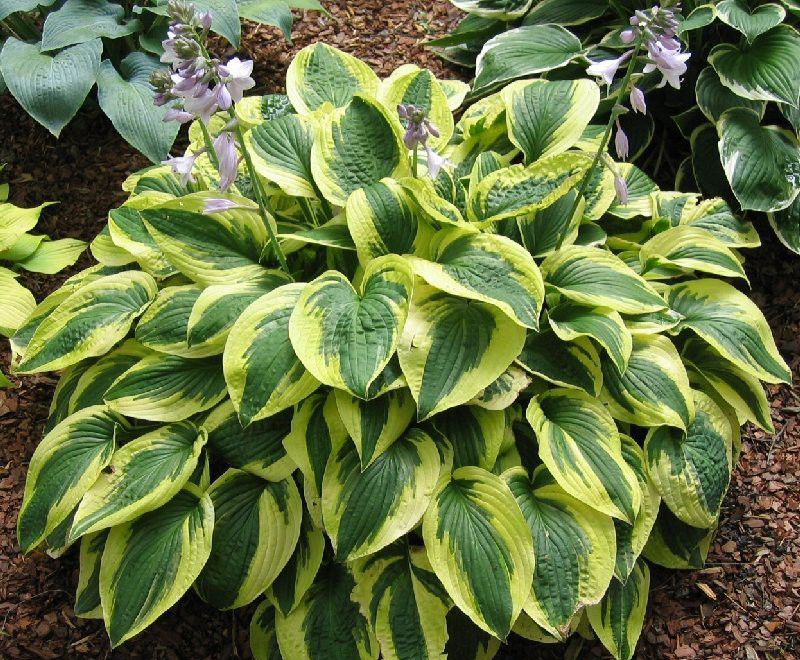
Hosta Wavy MediaVariety
When watering, you need to ensure that:
- Water does not get on the tips of the leaves - because of this, they can deteriorate.
- The jet would not be too strong - this can lead to compaction of the soil next to the plant.
- Watering was carried out in the early morning.
For this plant, infection with a fungal disease phyllostikosis is dangerous. The host also needs to be protected from pests.
If a plant is attacked by slugs, a folk method can be used to combat them. At the same time, containers with beer are placed around the diseased plant, slugs, attracted by the smell, leave the host. Then they are collected and destroyed.
When attacking caterpillars or grasshoppers, specialized chemical agents will be required for protection.
Breeding methods
The most effective method is to divide the bush. From the "delenka" you can get a full-fledged healthy plant for the next year, after planting in the ground.
Division method:
- Choose a healthy mother bush from the age of 4 years.
- Dig up the plant.
- Remove soil from roots.
- Use a sharp knife or pruning shears to separate the “delenka” with 3 or more buds.
- Lubricate the cut with wet sand.
- Return the mother bush to fertilized soil.
Important! The division is recommended at the end of the summer. During this period, the buds are already formed and the plant is more likely to take root.
It is better to divide hosta bushes in spring and late summer.
For propagation of wavy hosts "Mediovariygata", the method of grafting is suitable. It allows you not to dig out the bush. Hosta can be propagated by seed, but this process is time consuming and laborious.
Buying a plant
You can buy hosta seedlings in a specialized store. At the same time, you need to be able to choose the healthiest plants:
- You need to take a closer look at the root system of the seedling. She should look strong and healthy.
- Leaf buds of seedlings should be well-defined and developed. If the leaves have already unfolded, it is not recommended to make a purchase. In this case, the root system will be weakened, after planting in the soil, it will develop slowly.
Mediovariety
Plants that are sold in pots are not recommended to be bought as seedlings. Although, looking at them, you can see what color the plant will have, nevertheless, it will be difficult for them to take root in a new place.
After the purchase, you need to create conditions for the seedlings so that they are well preserved before planting in the ground. To do this, they must be placed in a dark and cool place. If rot forms during storage, it must be removed; it is recommended to grease the cut point with brilliant green.
Before planting, the roots of the plant are treated with a weak solution of potassium permanganate. The plant is allowed to be planted in the ground, both in autumn and spring. If you choose the first option, then this should be done at the very beginning of autumn. The best time is in late August and early September. At the same time, the seedling will have time to take root in a new place.
In the event that spring is chosen for planting, it is recommended to wait until the frost has passed, and soon after that, plant the plant in the ground.
Landing
The purchase of wavy undulata planting material can be done at the market or in a store.
When choosing a plant, you should pay attention to the state of its root system. It must be characterized by health, strength and good kidney development.
It is worth abandoning the purchase of a hosta whose leaves have already unfolded, since it will not take root well. Preservation of a sleeping representative of the flora is possible when it is placed in a cool and poorly lit place.
Planting hosts of "Mediovariegat" can be carried out both in the autumn and in the spring. The most suitable time for this procedure is the last week of August or the first days of September. It is necessary to plant a crop in soil with humus. The plant does not show exactingness to the structure of the soil. The host does not feel well in sandy and heavy loamy substrates.
To plant a culture, it is necessary to dig a wide hole, which will contribute to the horizontal growth of the root system. It is worth adding sand to the pit, which is mixed with peat, manure, compost soil.
After that, the seat is watered. Before starting planting, it is worth straightening the root system of the plant. It is not worth deepening the kidney, it should not be below ground level. At the end of planting, the host should be well watered, and the trunk circle should be mulched with peat about 2 centimeters. After a while, the bush will begin to grow, however, it is not worth replanting.

